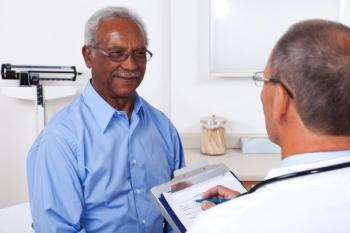
Epcoritamab Yields Durable Responses in Relapsed/Refractory LBCL
An expansion cohort from the phase 2 EPCORE NHL-1 trial demonstrated strong efficacy of epcoritamab in patients with relapsed/refractory large B-cell lymphoma.
Epcoritamab (DuoBody- CD3xCD20) showed durable responses and efficacy for patients with relapsed/refractory large B-cell lymphoma (LBCL), according to results of the phase 2 EPCORE NHL-1 expansion cohort (NCT03625037) presented at the
An overall response rate (ORR) of 63% (95% CI, 55%-71%) with a complete response (CR) of 39% (95% CI, 31%-47%) was observed in the overall population of patients treated with epcoritamab (n = 157). In those who were naïve to CAR T-cell therapy, 69% had an ORR and 42% had a CR. Of the patients who had previously received CAR T-cell therapy, with an ORR of 54% and 34% had a CR. The median follow-up was 10.7 months and the median duration of response (DOR) was estimated to be 12 months. The median DOR for those achieving a CR was not reached, and 89% of patients were still in CR at 9 months.
“Large B-cell lymphoma is a fast-growing, difficult-to-treat type of aggressive non-Hodgkin’s lymphoma. Some treatment approaches like chemotherapy and immunotherapy have been in place for decades and newer treatments like CAR T-cell therapies involve multiple steps before a patient can begin treatment, so there is still a need for additional treatment options,” Catherine Thieblemont, professor and head of the Hemato-Oncology Department at Hôpital Saint-Louis in Paris, France, said in a news release. “The data presented today suggest that epcoritamab has the potential to provide patients living with LBCL an accessible, effective treatment with a safety profile that may fulfill an unmet need.”
Previous results were announced in April 2022 for patients who had received at least 2 prior lines of systemic therapy, 38.9% of whom had prior CAR T-cell therapy.3 The median number of lines of prior therapy was 3.5. Patients received weekly subcutaneous epcoritamab at 48 mg during cycles 1 to 3, biweekly doses during cycles 4 to 9, and 4 times per week for cycles 10 and beyond. Patients continued treatment until disease progression or unacceptable toxicity, with inpatient monitoring required for the first 24 hours.
Sixty-one percent of patients were refractory to prior treatment, 20% had prior autologous stem cell transplantation, and 39% had received CAR T-cell therapy. The median patient age was 64 years, with 50% having an ECOG performance score of 1. Of the entire cohort, 89% had diffuse large B-cell lymphoma, 70% had de novo diffuse large B-cell lymphoma (DLBCL), 9 patients had high-grade B-cell lymphoma, 4 had primary mediastinal LBCL, and 5 had follicular lymphoma of grade 3B.
Roughly 1 in 4 patients (24%) experienced progressive disease and 3% had stable disease with epcoritamab treatment. At data cutoff, 32% of patients were continuing treatment and 68% had discontinued due to progressive disease (53%), adverse effects (AEs; 7%), allogeneic stem cell transplant(4%), withdrawal by patients (3%), or other reasons (1%).
Consistent data were derived across subgroups, without regard for age, histology, CAR T-cell therapy exposure, and number of lines of prior treatment patients, for an ORR of 46%. In 96 patients who were naïve to CAR T-cell therapy, the ORR was 69% with 27% having a CR. Those who were older than 75 years (n = 29) had an ORR of 72% and those with transformed DLBCL (n = 40) had an ORR of 68%.
The median overall survival was not reached, and the rate at 6 and 12 months were 70.6% (95% CI, 62.7%-77.2%) and 56.9% (95% CI, 47.3%-65.4%), respectively. The median progression-free survival (PFS) was not reached in patients with CR, with 89% of those maintaining their response at 9 months. The median PFS in the overall population was 4.4 months (95% CI, 3.0-7.9) and the rate at 6 months was 43.9% (95% CI, 35.7%-51.7%).
AEs were mostly observed during the first 3 treatment cycles, with cytokine release syndrome (CRS; 49.6%), neutropenia (28%), pyrexia (23.5%), and fatigue (22.9%) occurring most frequently. Immune effector cell–associated neurotoxicity syndrome (ICANS) of grade 1 or 2 was observed in 9 patients, all of which resolved; 1 patient experienced a grade 5 ICANS. Of those who experienced CRS, 2.5% experienced grade 3 events. The median time to onset from the first full dose was 20 hours, with 98.7% of patients having full resolution of CRS. The median time to resolution from the first full dose was 48 hours. One patient discontinued treatment due to CRS.
References
- Thieblemont C, Phillips T, Ghesquieres H, et al. Primary results of subcutaneous epcoritamab dose expansion in patients with relapsed or refractory large B-cell lymphoma: a phase 2 study. Presented at: 2022 EHA Congress; June 9-12, 2022; Vienna, Austria. Abstract LB2364
- AbbVie announced late-breaking results from phase 2 trial of investigational epcoritamab (DuoBody-CD3xCD20) in patients with relapsed/refractory large B-cell lymphoma (LBCL) at the European Hematology Association (EHA) Annual Congress. News Release. AbbVie. June 11, 2022. Accessed June 13, 2022. https://bit.ly/3zAcjf4
- AbbVie and Genmab announce topline results for Epcoritamab (DuoBody-CD3xCD20) from phase 1/2 trial in patients with relapsed/refractory large B-cell lymphoma (LBCL). News Release. AbbVie. April 13, 2022. Accessed June 13, 2022. https://bit.ly/3xJ16aC
Newsletter
Stay up to date on recent advances in the multidisciplinary approach to cancer.































































































